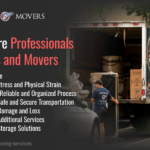What to Know Before Moving to Chicago
Moving from the Big Apple in the Northeast to the Windy City in the Midwest is a big step. While the two major urban centers share many similarities, some of the differences might catch you by surprise.
Here’s what you need to know:
The Weather
Get ready to enjoy all four seasons. Unlike NYC, weather patterns do not blow in from the cold Atlantic Ocean. Chicago sits in the middle of the nation along the coast of Lake Michigan. Summers are hot. Winters are snowy, the Fall is often windy, and Spring is the wettest time of the year. Chicago gets much colder in the winter than NYC. Icy conditions are more intense and last longer, but Chicagoans tend to handle the extremes well. The city provides warming stations for residents, and local laws require landlords to heat apartments to at least 63 degrees.
Transportation
Chicago’s Public Transit Authority is the second largest in the country. Eight of the famous “L” train lines run above the city traffic zipping passengers back and forth between the central city loop and the outlying areas. A fleet of buses supports all regions in between.
When the weather’s nice, take a water taxi along the Chicago River to destinations along Lake Michigan or ride a bike. Partnering with the Chicago Department of Transportation, Divvy provides over 5000 bicycles for citizens to share. A cell phone app helps you locate and unlock a bike throughout the city.
While New Yorkers often forego a personal vehicle, many in Chicago prefer to drive themselves. The region has notoriously lousy traffic jams along the major interstates that rival some the worst gridlock you might recognize from NYC.
Chicago Taxes
Chicago’s tax system puts more of the burden on property owners than wage earners. Your new tax situation looks something like this:
- 95% Illinois Flat Income Tax
- 25% Chicago Sales Tax which includes the 6.25% State Sales Tax
- Average 2.32% Property Tax in the area
Chicago’s property tax is notoriously high, nearly double that of the rest of the nation.
The good news is that the city does not impose an additional income tax like NYC does to workers and residents. As a New Yorker, your state income tax might have been more than 8%. NYC takes up to 3.876% more if you earn over 50K a year but allows property owners off the hook with a mere 0.8% property tax.
Real Estate and Home Buying
Chicago residents find homes in new condominium high rises, renovated industrial buildings, and classic row houses. Since the recession of 2008, property values have steadily increased, but the market began to cool in 2018. The new Federal Income Tax laws contributed to price stabilization.
You might find a two-bedroom condo in the low $200,000 range, but there’s no limit to how much you can spend. If you have the resources, the city occasionally sees luxury residential listings for over $10 million.
Entertainment
Chicago is famous for its restaurants, cafés, bars, and nightlife. Styles and venues change often, and top chefs from around the globe introduce new menu items at some of the best restaurants in the world.
With over 20 miles of coastline along the shore of Lake Michigan, there is plenty of opportunity for outdoor recreation. This area also has the city’s most impressive museums, art galleries, and a free public zoo. Two MLB baseball teams split the affections of the home crowd between north and south sides of the city. The NFL Bears, NHL Blackhawks, and NBA Bulls also compete for ticket sales.
The Cost of Living
Chicago is far more affordable than NYC. Rent for a two-bedroom apartment may be as low as $1400, which could save you several hundred dollars a month. The median income in Chicago is low for a major city at $68K a year. Comparatively, NYC’s median annual salary is $75K, but your money goes farther in Chicago. Across the board, transportation, taxes, housing, consumer prices, and entertainment all cost less on average. Economists estimate an individual might be able to squeak by with the essentials on an annual income of about $48,000.
Job Market and Major Industries
Work prospects in Chicago are good. The city’s unemployment rate finally dropped below 6% in 2015, and it’s been trending downward ever since. The multilayered economy supports many professions, but Chicago is a working-class town. Unions have always enjoyed a strong influence.
As a crossroads of the Midwest, the city developed a robust transportation network and industry. Railroad, shipping, warehousing, and truck lines all run major routes to support local manufacturing, and food processing businesses. The city’s printing and publishing industry rivals that of NYC and is the second largest in the nation. The Federal Reserve Bank’s Midwest headquarters is in Chicago, and the financial sector has insurance, banking, and commodities trading jobs for qualified professionals.
Best Neighborhoods to in Chicago
NYC is a city of five sprawling boroughs, but Chicago is a town of small neighborhoods. Divided into 77 commonly recognized districts, residents develop strong attachments to their local communities.
Logan Square
Logan Square is the crossroads where early settlers gathered to socialize, celebrate, and conduct business, and this neighborhood still focuses on its small community traditions. At the heart of this historic district, the Illinois Centennial Monument commemorates 100 years of statehood, and the area is the home of many traditional church buildings.
Residents enjoy quiet neighborhoods, stately looking Greystone buildings, and bungalow-style housing rows. Boutique shops provide amenities, and a local farmers market brings in fresh produce every week. The blue line of the “L” train system connects you with the center of the city.
Something to Try: Find your favorite craft beer tavern along North Milwaukee Avenue.
Lakeview
Belmont Harbor and Montrose Beach sit within the bounds of Lakeview along the shores of Lake Michigan. To the north, Wrigley Field, home of the Chicago Cubs, takes up several blocks.
One of the more densely packed regions, nearly 100,000 residents call Lakeview home. Despite the close quarters, the neighborhood consistently ranks high on lists of best big city neighborhoods. Affordable housing, relatively low crime, and an abundance of parks and green spaces make it attractive.
Something to Try: See a live show in the Belmont Theater District.
West Loop
Part of Chicago’s city center, this neighborhood has a lower population density with only about 33,000 residents. Urban renewal efforts transformed old factories, warehouses, and industrial zones into stylish new lofts and condominiums. More than half of residents rent, and an average apartment could cost upwards of $1800 per month.
Close to downtown, employment opportunities are abundant, and West Loop is popular with many young professionals. In addition to other public transportation options, residents may access the city’s water taxi service from the Chicago River to the east.
Something to Try: Check out the Chicago French Market, the only indoor market operating all year round.
South Loop
You might find it difficult to obtain an affordable residence in the South Loop right away. A few row houses and apartments exist, but most of the area supports civic institutions. Still, keep your eye on this area.
Along the Lake Michigan waterfront, a host of museums, theaters, and parks take up the real estate. The McCormick Place, a massive multi-purpose convention center, hosts performances, conferences, and events throughout the year. Interestingly, developers announced plans to build along the shore of the Chicago River just east of South Loop. Referred to as “The 78,” this new 78th neighborhood inside Chicago will support the growing population with 62 acres of new homes, shops, and parks.
Something to Try: Skip over to China Town and visit the Chinese American Museum of History.
Printer’s Row
The old buildings of Printer’s Row used to contain the massive machinery needed to publish books, magazines, newspapers, and other media. Renovated and transformed into condos, this tiny neighborhood is home to less than 10,000 of Chicago’s residents.
Rents are affordable for a large city with a two-bedroom condo costing about $1500, Nearly two-thirds of citizens prefer to rent, but ownership opportunities are available with condo prices starting in the low $300,000s.
Local businesses provide coffee shops, bars, restaurants, and shopping opportunities, and the district is right next door to Chicago’s Loop district for plenty of job opportunities.
Something to Try: Cross the street to visit the old Dearborn Station building, once the transportation hub of the Midwest.
Gold Coast
North of the City Center, the Gold Coast neighborhood lives up to its name. One of the older districts, city planners designed this area following the Chicago fire of 1871. Residents now live in a mixture of luxury row houses, high rise apartments, and mansions.
It is one of the most affluent neighborhoods in the country. Median income is higher than $153,000 a year, and home prices easily reach seven figures. The wealthy enjoy easy access to the beach and some of the best dining, shopping, and entertainment in the city.
Something to Try: Cruise down Rush Street and discover a unique dining experience.
River North
This stylish urban neighborhood borders Chicago’s famed Magnificent Mile. From the city center, hop over the Chicago River and follow the rows of luxury shops and restaurants into this trendy district.
In the late 1970s and early 1980, developers repurposed old factories and warehouses to make space for new residences. A small condo might set you back $300,000, but luxury housing is also available depending on your budget.
Award-winning upscale restaurants and bars are within walking distance for most, and the Magnificent Mile is the Midwest’s premier commercial district.
Something to Try: Stroll through trade shows and discover the latest market tends at Merchandise Mart.
Lincoln Park
Lincoln Park has 1208 acres of green spaces sprinkled throughout its borders. The shores of Lake Michigan provide residents with access to beaches, parks, and museums.
This affluent neighborhood is on the north side of the city and is home to many upscale retailers and boutique shops. Residential housing prices are high, but the area has plenty of brick row homes and condos. DePaul University is nearby offering undergraduate and graduate studies.
Something to Try: Take the kids to the free Lincoln Park Zoo as often as you like.
Hyde Park
This neighborhood is on the southern side of the city and receives much of the credit for Chicago’s success. As host of the 1893 World Fair, Hyde Park helped to jump-start the local economy still struggling after the devastating fire of 1871.
Still popular with visitors, Hyde Park also has plenty to offer long term residents. The world-class University of Chicago is on the south side of this district, and the Museum of Science and Industry is on the shore of Lake Michigan to the East.
For the outdoor enthusiasts, the Midway Plaisance Park connects the green spaces along the coast with Washington Park. The local economy caters to college students, and housing prices remain reasonable. The median price for a suitable condo is just under $250,000.
Something to Try: Visit the Smart Museum of Art next to the Joseph Regenstein Library.
Tips for Moving Cross Country from NYC to Chicago
There are 790 miles of driving distance between NYC and Chicago. Start organizing and planning your move as soon as you know for sure you’re going to relocate. You don’t want to have to turn back halfway for something you forgot!
Downsize, Prepare, and Pack
The average 10 x 10 storage unit in Chicago will run you about $100. That’s money you can put to better use. Before you pull up stakes and charge West, get rid of as many of your unnecessary things as possible.
Ideally, start liquidating extra belongings six months ahead of your move. You can sell unwanted furniture and clothes by placing ads online. Donate or discard anything that doesn’t sell.
Consider the Pros of Hiring a Mover
Also, consider hiring a professional mover to help with your relocation. You might save a buck by doing the work yourself, but moving companies, like Imperial Moving & Storage, often offer door to door relocation packages that save you time and save your back.
- The Basic A to B Service: Your moving team loads a truck for you and drives to your new residence.
- Partial Pack Services: If you need help with some of the packing, movers assist you by boxing up some of your belongings or areas.
- Full Move service: The movers do all the work while you enjoy your trip to Chicago.
Moving companies provide-door to-door relocation services for any size residence. You might only need help to clear out a college dorm room, or you could hire a moving company to relocate your family’s five-bedroom home completely.
For many NYC residents, there is much appeal to hiring movers. Instead of navigating narrow streets or lugging furniture up and down stairs yourself, the professionals take care of these hassles for you.
Ask About Insurance
Always ask about the insurance options provided by the moving company. While every licensed mover must carry liability, it costs extra to protect your valuables from harm. Get the best coverage you can afford.
Book Your Moving Company ASAP
Also, make your arrangements to hire movers as soon as possible. It’s not unreasonable to start shopping several months before the event. In many cases, you will need to meet with the company’s representative to discuss the details and go over the plan. Ask questions and make sure you know what to expect.
Only work with a reputable moving company and try to avoid moving on holidays or during times when traffic is heavy. Some moving packages charge by the hour and some charge by the mile of transportation. Remember, Imperial Moving & Storage is a fully licensed, insured, and bonded interstate moving company, offering affordable rates on long-distance moves.
If you do decide to perform the move yourself, make sure you reserve your truck and equipment right away. Waiting until the last minute increases the odds that the vehicle you need won’t be available.
Take Care of Business
Notify essential contacts of your intention to move. Some businesses and government agencies require notice within a specific time frame.
- Provide landlords with 30-days written notice of your intent.
- Notify utilities and service providers at least 30 days before the move.
- Give employers 2-week notice before quitting a job.
- Cancel memberships to libraries, gyms, clubs, etc.
- Tell subscription providers like magazines or online clubs where to find you.
- Inform creditors of your new address before the next billing cycle.
- Transfer medical prescriptions and primary care provider the week you move.
If you don’t yet know your permanent address, then set up a temporary mailbox at the post office in Chicago.
Survey Your Things
Inventory your items and ensure none of your things are missing or broken. Do this as soon as possible. The longer you wait to file a claim with your moving company, the harder it is to receive compensation.
Settle into Your New Routine
Enroll the kids in new school districts and get to know the location of emergency services in the neighborhood. Take a drive around to familiarize yourself with the streets and the best routes.
Update Your Vehicle Registration & Drivers’ License
The Illinois Office of the Secretary of State administers driver and vehicle licenses. Visit the Secretary of State office closest to you within 90 days. Surrender your old driver’s license, pay the fee, and pass the eye and written exams to get your new driver’s license. You can also register to vote at this time, though you may also submit your voter registration separately with the State Board of Elections.
If you have a car to register, update your auto insurance to comply with Illinois standards and pass a vehicle emissions test. Boats and some other recreational vehicles must register with the state’s Department of Natural Resources.
Becoming a Chicagoan
Settle into your new home in Chicago. Though still the big city, you’ll discover that the Midwestern attitudes towards strangers are a bit friendlier than what you might have experienced in New York. Get out there and mingle!
For assistance planning your big move from New York to Chicago, contact Imperial Moving & Storage now. We’re ready to help you navigate the long-distance moving process! Request a free quote today.












